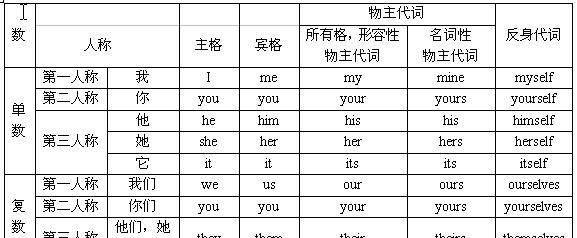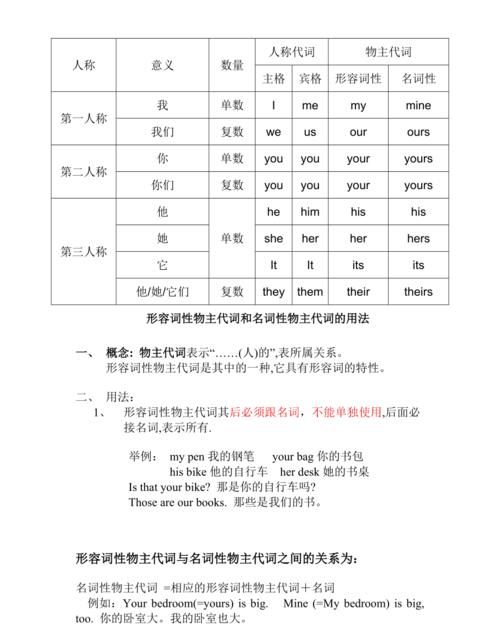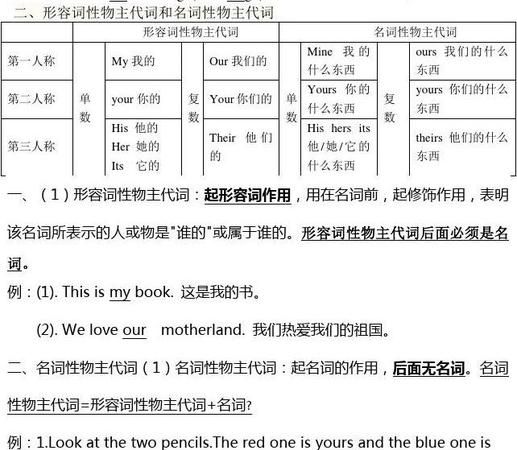本文目录

指示代词直接接名词的作用是什么
应该叫物主代词。
物主代词分为名词性物主代词和形容词性物主代词。在使用时,形容词性物主代词后面必加名词,而名词性物主代词后面不加名词。

总结一下代词的用法英语
代词是代替名词的一种词类。大多数代词具有名词和形容词的功能。英语中的代词,按其意义、特征及在句中的作用分为:人称代词、物主代词、指示代词、自身代词、相互代词、疑问代词、关系代词和不定代词八种。
一、人称代词是表示"我"、"你"、"他"、"她"、"它"、
"我们"、"你们"、"他们"的词。人称代词有人称、数和格的变化,见下表:
数 单数 复数
格 主格 宾格 主格 宾格
第一人称 I me we us
第二人称 you you you you
he him they them
第三人称 she her they them
it it they them
如:Heismyfriend. 他是我的朋友。
It’sme. 是我。
二、物主代词表示所有关系的代词,也可叫做代词所有格。物主代词分形容性物主代词和名词性物主代词二种,其人物和数的变化见下表。
数 单数 复数
人称 第一 第二 第三 第一 第二 第三
人称人称 人称 人称 人称 人称
形容词性 my your his/her itsouryour/their
物主代词
名词性 mineyourshis/hersitsoursyours/theirs
物主代词
如:Ilikehiscar.
我喜欢他的小汽车。
Ourschoolishere,andtheirsisthere.
我们的学校在这儿,他们的在那儿。
三、指示代词表示"那个"、"这个"、"这些"、"那些"等指示概念的代词。指示代词有this,that,these,those等。
如:Thatisagoodidea. 那是个好主意。
四、表示"我自己"、"你自己"、"他自己"、"我们自己"、"你们自己"和"他们自己"等的代词,叫做自身代词,也称为"反身代词"。
如:Shewastalkingtoherself. 她自言自语。
五、表示相互关系的代词叫相互代词,有eachother和oneanother两组,但在运用中,这两组词没什么区别。
如:Theyloveeachother. 他们彼此相爱。
六、不是指明代替任何特定名词的代词叫做不定代词。常见的不定代词有a11,both,each,every等,以及含有some-,any-,no-等的合成代词,如anybody,something,noone。这些不定代词大都可以代替名词和形容词,在句中作主语、宾语、表语和定语, 但none和由some,any,no等构成的复合不定代词只能作主语、宾语或表语;every和no只能作定语。如:
---Doyouhaveacar? --你有一辆小汽车吗?
---Yes,Ihaveone. --是的,我有一辆。
---Idon’tknowanyofthem. 他们,我一个也不认识。
七、疑问代词有who,whom,whose,what和which等。在句子中用来构成特殊疑问句。疑问代词都可用作连接代词,引导名词性从句(主语从句、宾语从句和表语从句)
如:Tellmewhoheis. 告诉我他是谁。
八、关系代词有who,whom,whose,that,which,as等,可用作引导从句的关联词。它们在定语从句中可作主语、表语、宾语、定语等;另一方面它们又代表主句中为定语从句所修饰的那个名词或代词(通称为先行词)。
如:Heisthemanwhomyouhavebeenlookingfor. 他就是你要找的那个人.
===============================
代词的用法
几类代词的相应形式:
人称代词
物主代词
反身代词
主格
宾格
形容词性
名词性
单数
I
I 我
me我
my我的
mine我的
myself我自己
II
you
you
your
your
yourself
III
he
him
his
his
himself
she
her
her
hers
herself
it
it
its
its
itself
复数
I
we
us
our
ours
ourselves
II
you
you
your
yours
Yourselves
III
they
them
their
theirs
themselves
人称代词的用法:1,主格作主语或表语:
She and Tom are good friends.
It's she who wants it.
2. 宾格作及物动词和介词的宾语,还可作表语.
Aunt Li took care of us.
Who is knocking at the door It's me.
物主代词的用法:
形容词性物主代词只能做定语,修饰名词,相当于形容词.
My mother is a nurse in a hospital.
Their teacher is coming here.
名词性物主代词可以做主语,宾语和表语,相当于名词.
This is my pen, yours is lost.(yours=your pen)
The best composition is hers. (hers= her composition)
I can't find my ruler, I have to use hers. (hers = her ruler)
反身代词的用法:
反身代词表示主语发生的动作落在主语自己身上,或用来加强名词或代词的语气.
作主语:I hope he didn't hurt herself. She taught herself English.
同位语: You yourself said so. You can do it yourself.
常与以下动词连用:
hurt, dress, enjoy, say to, talk to, teach, wash, help
还可以与介词连用:by oneself [自己(不需要别人帮忙)] for oneself (替自己,为自己)
to oneself(供自己用)
不定代词及用法:
(一)可分为普 通不定代词,个体不定代词和数量不定代词:
通不定代词:some, any, no, somebody, nobody, anybody, someone, anyone, no one, something, anything, nothing, one
个体不定代词:all, every, each, other, another, either, neither, both, everybody, everyone, everything
数量不定代词:many, much, few, a few, little, a little, a lot of, lots of
(二) 普通不定代词的用法(部分):
some一般用于肯定句, 当预期对方作肯定回答时也用于疑问句:
Could you please give me some information about ir
还用于表示要求和提供某物的句子:
Would you like some tea
2. any 的用法: (1)用于否定句及含有否定意义词(hardly, never, no)的句子中:
I have hardly any time.
(2)用于疑问句中和条件句中: Do you see any birds in the tree
(3) some, any, no, 与 one, thing, body 构成的合成词的用法:这些代词都表示单数的概念,some, any与one, thing, body构成的合成词的区别与和的用法基本相同.
There is someone looking for you outside.
If you want anything, call me, please.
这些代词如被定语修饰, 应放在定语前,如被else修饰,也放在else前:
Is there anything new in the newspaper
I'm afraid I can't help you, you'd better ask someone else.
3. other, another 的用法:
两者均可指人,也可指物,other 意为 "另外",不确指,需要确指时前加定冠词the, the other,,意为 another"另一个":
other: (1)后跟名词(单,复),泛指 "别的,其他的"
The Great Wall is longer than any other wall in the world.
I'll go swimming with other friends tomorrow.
the other后跟名词单或数,或后不跟名词, 特指两者中的另一个:
At last we got the other side of the river.
Thirty are girls and the other students are boys in our class.
I have two pens, one is blue and the other is red.
(3) others 后不加名词,泛指另外一些别的人或事物;the others 特指其余所有的人或事物:
Some of us like playing table-tennis, and others like playing basketball.
Thirty in our class are girls, and the others are boys.
(4) 泛指三者以上的 "一些"不用加the, 用 "some…. others"的形式:
Some people like it, others not.
another:
泛指另一个,不与the连用,只能跟可数名词单数:
I don't like this one, will you please show me another
We asked him to sing us another song.
4.both, either, neither的用法:他们均用于两者之间,neither, either用做单数,both用做复数,
both:肯定句中表示"两者都",用于否定句中表示 "两者不都",即部分否定:
Both of the sisters are good at English.]
Not both of them are good at English.(One is good at English, the other isn't.)
I don't know both his brothers. (I only know one of them.)
Both,,,and,,,, 连接两个主语时谓语动词用复数:
Both my bothers and I are teachers.
(2) neither: 表示"两个都不", either表示"两个中的任何一个", neither是 either的否定形式,两者均表示单数形式,做主语时谓语动词用单数形式:
Either you or he is right.
Neither he nor you is right.
neither是both的反义词,做形容词时与单数名词连用,不用the:
Neither pen writes good.= Neither of the pens writes good.
Neither…nor…, either…or….
Eihter you or I am right.
Nether you nor I am right.=Both you and I are right.
5. (a) little, much, (a) few, many 的用法:
little "很少"表否定, a little "少许"表肯定, much= not a little:
I know little about him. 我不了解他.
I know much about him. 我对他很了解.
There is little to be done, is there
There is a little to be done, isn't there
在对不可数名词提问时要用how much:
I spent a lot of money on books. How much did you spend on books
as little as "尽可能少的" as much as " 尽可能多的" as… as…结构中不用 a little
Few 表示 "很少" 表否定含义, a few "有一些"表肯定含义, many= not a few ""许多,不少, 这三个词用于修饰可数名词:
Few of us understand our teacher.
A few of us understand our teacher.
His book has few readers, does it
His book has a few readers, doesn't it
as few as "尽可能少" as many as "和……一样多" as…as…. 结构中不用a few

日语翻译
不可以,代词是体言,体言有名词、代词、数词,体言接体言中间要加の,所以代词和名词之间要加の

以上就是关于哪几种代词可以直接接名词 ,代词加名词的全部内容,以及哪几种代词可以直接接名词 的相关内容,希望能够帮到您。
